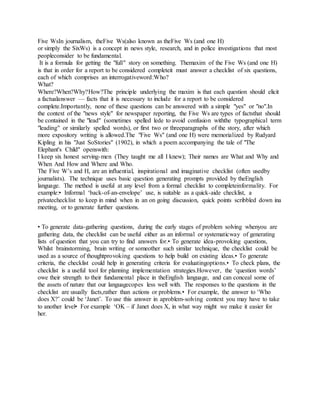Report
Share

Recommended
More Related Content
Similar to Five ws in journalism
Similar to Five ws in journalism (20)
Chapter 13: Speaking to Inform (Public Speaking and Persuasion)

Chapter 13: Speaking to Inform (Public Speaking and Persuasion)
This research paper is on the public perception on Collar.docx

This research paper is on the public perception on Collar.docx
Purpose, Team Formation, and Team Member Roles 10.0 Profession.docx

Purpose, Team Formation, and Team Member Roles 10.0 Profession.docx
Change language English DeutschEspañolNederlandsYour ResultsClosed.docx

Change language English DeutschEspañolNederlandsYour ResultsClosed.docx
BUS 210 Project One Management Brief Text-Only VersionOrganizati

BUS 210 Project One Management Brief Text-Only VersionOrganizati
Survey of English Literature ITwelfth Night Research Paper.docx

Survey of English Literature ITwelfth Night Research Paper.docx
Chapter 12Organization and OutlinesSpeech is power; speech is 

Chapter 12Organization and OutlinesSpeech is power; speech is
Word document of 750 words with attached Excel Spreadsheet showing.docx

Word document of 750 words with attached Excel Spreadsheet showing.docx
Five ws in journalism
- 1. Five WsIn journalism, theFive Ws(also known as theFive Ws (and one H) or simply the SixWs) is a concept in news style, research, and in police investigations that most peopleconsider to be fundamental. It is a formula for getting the "full" story on something. Themaxim of the Five Ws (and one H) is that in order for a report to be considered completeit must answer a checklist of six questions, each of which comprises an interrogativeword:Who? What? Where?When?Why?How?The principle underlying the maxim is that each question should elicit a factualanswer — facts that it is necessary to include for a report to be considered complete.Importantly, none of these questions can be answered with a simple "yes" or "no".In the context of the "news style" for newspaper reporting, the Five Ws are types of factsthat should be contained in the "lead" (sometimes spelled lede to avoid confusion withthe typographical term "leading" or similarly spelled words), or first two or threeparagraphs of the story, after which more expository writing is allowed.The "Five Ws" (and one H) were memorialized by Rudyard Kipling in his "Just SoStories" (1902), in which a poem accompanying the tale of "The Elephant's Child" openswith: I keep six honest serving-men (They taught me all I knew); Their names are What and Why and When And How and Where and Who. The Five W’s and H, are an influential, inspirational and imaginative checklist (often usedby journalists). The technique uses basic question generating prompts provided by theEnglish language. The method is useful at any level from a formal checklist to completeinformality. For example:• Informal ‘back-of-an-envelope’ use, is suitable as a quick-aide checklist, a privatechecklist to keep in mind when in an on going discussion, quick points scribbled down ina meeting, or to generate further questions. • To generate data-gathering questions, during the early stages of problem solving whenyou are gathering data, the checklist can be useful either as an informal or systematicway of generating lists of question that you can try to find answers for.• To generate idea-provoking questions, Whilst brainstorming, brain writing or someother such similar technique, the checklist could be used as a source of thoughtprovoking questions to help build on existing ideas.• To generate criteria, the checklist could help in generating criteria for evaluatingoptions.• To check plans, the checklist is a useful tool for planning implementation strategies.However, the ‘question words’ owe their strength to their fundamental place in theEnglish language, and can conceal some of the assets of nature that our languagecopes less well with. The responses to the questions in the checklist are usually facts,rather than actions or problems.• For example, the answer to ‘Who does X?’ could be ‘Janet’. To use this answer in aproblem-solving context you may have to take to another level• For example ‘OK – if Janet does X, in what way might we make it easier for her.